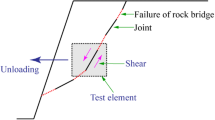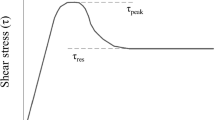Abstract
The shear mechanical behavior of discontinuities under unloading conditions induced by intensive rock mass excavation differs from that under loading conditions. Therefore, the mechanical parameters obtained from the conventional direct shear test cannot effectively be used to assess the stability of excavated rock masses. To solve this problem, we conducted a series of experiments on saw-toothed discontinuities with different undulating angles and initial shear stresses under unloading normal stress with constant shear stress. The test results showed that the shear pattern transformed from climbing to climbing-gnawing and then to gnawing patterns as the undulating angle and initial shear stress increased. The shear stress remained stable with increasing shear displacement after instability in the climbing pattern, decreased with fluctuations in the climbing–gnawing pattern, and dropped steeply in the gnawing pattern. A negative linear correlation exists between the unloading magnitude and the initial shear stress. Unloading normal stress promoted deformation rebound and sawtooth damage, reducing the mobilizing shear strength. Modified Patton and Barton shear strength criteria considering the undulating angle, initial stress, and failure pattern under unloading normal stress were proposed.
Highlights
-
The shear mechanical behavior of saw-toothed discontinuities with different undulating angles and initial shear stresses under unloading normal stress with constant shear stress are investigated.
-
The failure pattern changes from the climbing pattern to the climbing–gnawing pattern and then to the gnawing pattern as the undulating angle and the initial shear stress increase.
-
Unloading promotes the increase in rebound deformation and the area of the damage zone, leading to the decrease in shear strength of saw-toothed discontinuities.
-
The modified Patton criterion and the Barton criterion are proposed for unloading normal stress considering the undulating angle, initial stress state, and failure pattern.















Similar content being viewed by others
Data availability
The data that support the findings of this study are available from the corresponding author upon reasonable request.
References
Alameda-hernandez P, Jimenez-peralvarez J, Palenzuela JA, Hamdouni R, Chacon J (2014) Improvement of the JRC calculation using different parameters obtained through a new survey method applied to rock discontinuities. Rock Mech Rock Eng 47(6):2047–2060
Asadollahi P, Tonon F (2010) Constitutive model for rock fractures: revisiting Barton’s empirical model. Eng Geol 113(1):11–32
Bandis SC, Lumsden AC, Barton N (1983) Fundamentals of rock joint deformation. Int J Rock Mech Min Sci Geomech Abstr 20(6):249–268
Barton N (1973) Review of a new shear-strength criterion for rock joints. Eng Geol 7(4):287–332
Barton N, Choubey V (1977) The shear strength of rock joints in theory and practice. Rock Mech Rock Eng 10(1–2):1–54
Barton N, Bandis S, Bakhtar K (1985) Strength, deformation and conductivity coupling of rock joints. Int J Rock Mech Min Sci Geomech Abstr 22(3):121–140
Barton N (2016) Non-linear shear strength for rock, rock joints, rockfill and interfaces. Innov Infrastruct Solut 1(1):30
Beer AJ, Stead D, Coggan JS (2002) Technical note estimation of the joint roughness coefficient (JRC) by visual comparison. Rock Mech Rock Eng 35(1):65–74
Belem T, Ahomand-Etienne SM (2000) Quantitative parameters for rock joint surface roughness. Rock Mech Rock Eng 33(4):217–242
Cai M (2008) Influence of stress path on tunnel excavation response—numerical tool selection and modeling strategy. Tunn Undergr Space Technol 23(6):618–628
Casagrande D, Buzzi O, Giacomini A, Lambert C, Fenton G (2018) A new stochastic approach to predict peak and residual shear strength of natural rock discontinuities. Rock Mech Rock Eng 51(1):69–99
Cen DF, Huang D (2017) Direct shear tests of sandstone under constant normal tensile stress condition using a simple auxiliary device. Rock Mech Rock Eng 50(6):1425–1438
Cong Y, Wang Z, Zheng Y, Zhang L (2020) Effect of unloading stress levels on macro- and microfracture mechanisms in brittle rocks. Int J Geomech 20(6):04020066
Dang W, Konietzky H, Herbst M, Frühwirt T (2017) Complex analysis of shear box tests with explicit consideration of interaction between test device and sample. Measurement 102:1–9
Feng F, Chen S, Wang Y, Huang W, Han Z (2021) Cracking mechanism and strength criteria evaluation of granite affected by intermediate principal stresses subjected to unloading stress state. Int J Rock Mech Min Sci 143(5):104783
Feng XT, Xu H, Yang CX, Zhang XW, Gao YH (2020) Influence of loading and unloading stress paths on the deformation and failure features of Jinping marble under true triaxial compression. Rock Mech Rock Eng 53(1):3287–3301
Goodman R (1989) Introduction to rock mechanics. Springer, Dordrecht
Grasselli G, Egger P (2003) Constitutive law for the shear strength of rock joints based on three-dimensional surface parameters. Int J Rock Mech Min Sci 40(1):25–40
Gui Y, Xia CC, Ding WQ, Qian X, Du SG (2018) Modelling shear behavior of joint based on joint surface degradation during shearing. Rock Mech Rock Eng 52:107–131
Huang D, Li Y (2014) Conversion of strain energy in triaxial unloading tests on marble. Int J Rock Mech Min Sci 66:160–168
Huang RQ, Huang D (2014) Evolution of rock cracks under unloading condition. Rock Mech Rock Eng 47(2):453–466
Huang D, Cen DF, Song YX (2020a) Comparative investigation on the compression–shear and tension–shear behavior of sandstone at different shearing rates. Rock Mech Rock Eng 53:3111–3131
Huang D, Guo YQ, Cen DF, Zhong Z, Song YX (2020b) Experimental investigation on shear mechanical behavior of sandstone containing a pre-existing flaw under unloading normal Stress with constant shear stress. Rock Mech Rock Eng 53(8):3779–3792
Kulatilake PHSW, Shou G, Huang TH, Morgan RM (1995) New peak shear strength criteria for anisotropic rock joints. Int J Rock Mech Min Sci 32(7):673–697
Liu QS, Tian YC, Ji PQ, Ma H (2018) Experimental investigation of the peak shear strength criterion based on three-dimensional surface description. Rock Mech Rock Eng 51(4):1005–1025
Park JW, Lee YK, Song JJ, Choi BH (2013) A constitutive model for shear behavior of rock joints based on three-dimensional quantification of joint roughness. Rock Mech Rock Eng 46(6):1513–1537
Patton FD (1966) Multiple modes of shear failure in rock. In: Proceedings of the 1st congress of international society of rock mechanics, vol 1. Lisbon, pp 509–513
Tatone BSA, Grasselli G (2013) An investigation of discontinuity roughness scale dependency using high-resolution surface measurements. Rock Mech Rock Eng 46:657–681
Xia CC, Gui Y, Wang W, Du SG (2014) Numerical method for estimating void spaces of rock joints and the evolution of void spaces under different contact states. J Geophys Eng 11(11):065004
Xu H, Feng XT, Yang C, Zhang X, Zhou Y, Wang Z (2019) Influence of initial stresses and unloading rates on the deformation and failure mechanism of Jinping marble under true triaxial compression. Int J Rock Mech Min Sci 117:90–104
Zandarin MT, Alonso E, Olivella S (2013) A constitutive law for rock joints considering the effects of suction and roughness on strength parameters. Int J Rock Mech Min Sci 60(2):333–344
Zheng B, Qi S, Huang X, Guo S, Luo G (2020) An advanced shear strength criterion for rock discontinuities considering size and low shear rate. Appl Sci 10(12):4095
Zhong Z, Huang D, Zhang YF, Ma GW (2020) Experimental study on the effects of unloading normal stress on shear mechanical behavior of sandstone containing a parallel fissure pair. Rock Mech Rock Eng 53(2):1647–1663
Zhu T, Huang D (2019) Experimental investigation of the shear mechanical behavior of sandstone under unloading normal stress. Int J Rock Mech Min Sci 114:186–194
Acknowledgements
The present work is supported by the National Natural Science Foundation of China (no. 41972297) and the Natural Science Foundation of Hebei Province (no. D2021202002).
Author information
Authors and Affiliations
Corresponding author
Ethics declarations
Conflict of interest
The manuscript “Effects of undulation and stress on the shear mechanical behavior of saw-toothed discontinuities under unloading normal stress” is submitted for possible publication in Rock Mechanics and Rock Engineering. This manuscript has not been published previously and is not under consideration for publication elsewhere now (not submitted to more than one journal for simultaneous review). If accepted, it will not be published elsewhere in the same form. This study is not split into several parts to increase the number of submissions. The proper acknowledgments to other works have been given. All authors appearing on the submission declare no conflict of interest in the submitted manuscripts and consent to submit. And they have contributed significantly to work submitted.
Additional information
Publisher's Note
Springer Nature remains neutral with regard to jurisdictional claims in published maps and institutional affiliations.
Rights and permissions
Springer Nature or its licensor (e.g. a society or other partner) holds exclusive rights to this article under a publishing agreement with the author(s) or other rightsholder(s); author self-archiving of the accepted manuscript version of this article is solely governed by the terms of such publishing agreement and applicable law.
About this article
Cite this article
Guo, YQ., Huang, D. & Li, YL. Effects of Undulation and Stress on the Shear Mechanical Behavior of Saw-Toothed Discontinuities Under Unloading Normal Stress. Rock Mech Rock Eng 57, 307–324 (2024). https://doi.org/10.1007/s00603-023-03580-0
Received:
Accepted:
Published:
Issue Date:
DOI: https://doi.org/10.1007/s00603-023-03580-0




